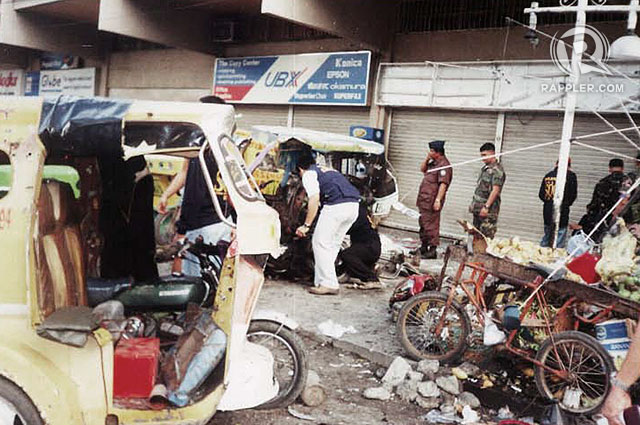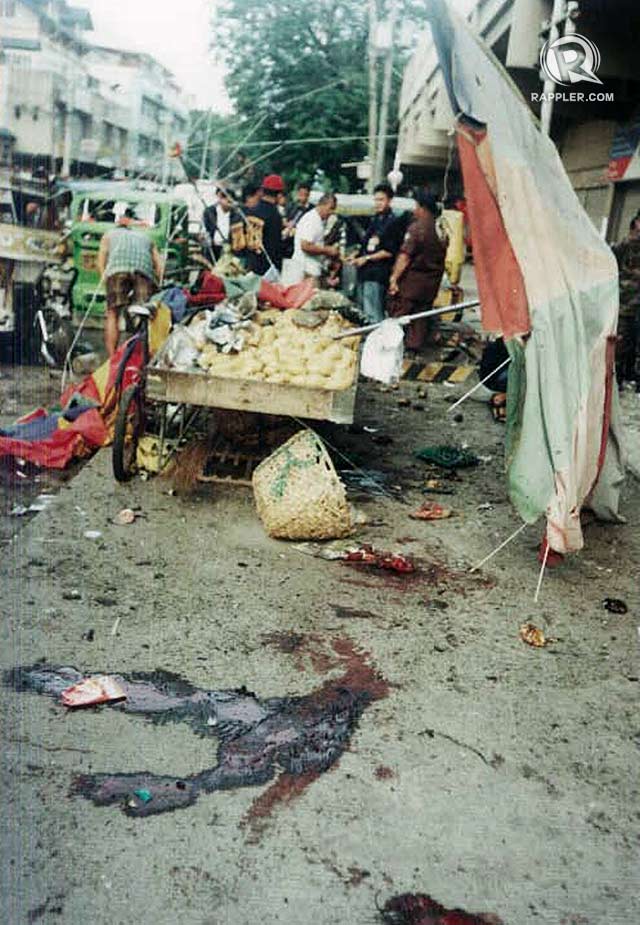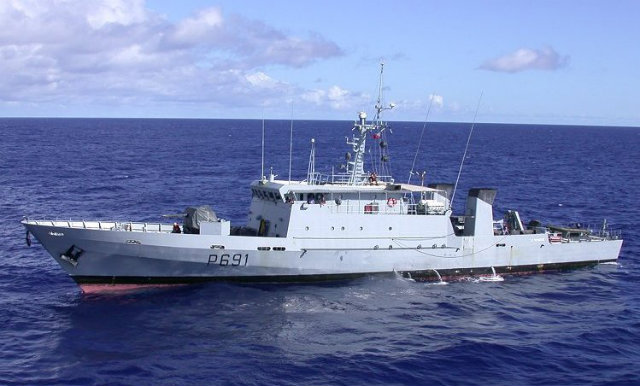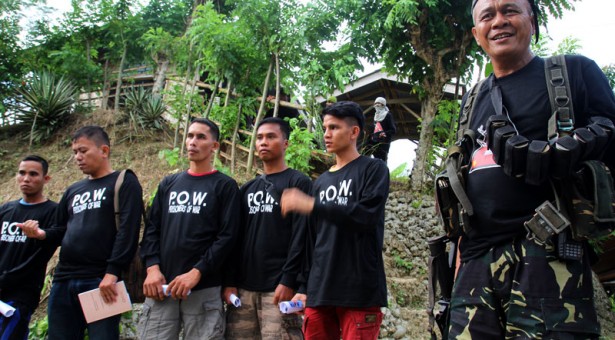From Rappler (Aug 3):
Mindanao bombs: over 300 killed in 12 yrs
 SEARCH.
Investigators sift through the rubble after an explosion outside the Fitmart
Department Store in April 2002. Photos by Edwin Espejo
SEARCH.
Investigators sift through the rubble after an explosion outside the Fitmart
Department Store in April 2002. Photos by Edwin Espejo
The powerful blast in Cagayan De Oro on July 26 was one of the deadliest of bloody bombing attacks in Mindanao in more than two years.
Eight people were killed (6 of them on the spot) when a still undetermined explosive device tore through a bar in Limketkai Center more than a week ago, on a Friday night.
Although the number of casualties may not be as staggering as other Mindanao bombings in the past, it finally broke the Northern Mindanao city’s relative immunity from terror attacks.
Many are now wishing the Limketkai bombing will not be a portent of things to come for Cagayan de Oro, although there were two incidents prior to it.
Beyond Cagayan de Oro, hub of trade and commerce in Northern Mindanao, other cities and regions across the island have gone through worse agonies.
| Region | Incidents | Killed | Wounded |
|---|
| Soccsksargen | 25 | 125 | 585 |
| ARMM | 15 | 81 | 349 |
| Zamboanga Peninsula | 10 | 48 | 336 |
| Davao Region | 6 | 52 | 315 |
| Northern Mindanao | 5 | 48 | 190 |
| Total | 61 | 354 | 1775 |
|---|
Hardest hit region
But it is not in war-torn regions where most of the deadliest bombing attacks occurred from 2000 to 2012. Rather, it is in Region 12 or Soccsksargen, where you find the cities of General Santos, Cotabato, Kidapawan, Koronadal, and Tacurong, and the provinces of South Cotabato, Cotabato, and Sultan Kudarat, and Sarangani.
In the last 12 years, a total of 25 bombing and grenade attacks occurred in the region.
In terms of the number casualties and the number of bomb explosions, no area in Mindanao can surpass General Santos City.
At least 13 bombs exploded in 7 bombing attacks in the city, killing 48 people and wounding at least 201 others, all of them civilians.
The casualty figures in General Santos accounted for 38% of the 125 civilians killed and 21% of the 585 wounded in the bombing attacks in the region during the period.
The bloodiest were the April 21, 2002 Fitmart explosion and the Dec 12, 2004 bombing attack in the meat section of the GenSan public market. At least 15 people were killed in each explosion, while 55 and 64 people were injured respectively. The police authorities blamed the terror attacks on the Abu Sayyaf-Jemaah Islamiya terror group.
Powerful blasts in Tacurong City (Dec 31, 2002) and Koronadal City (May 9, 2003) also each claimed the lives 10 civilians and wounded a total of 74.
Ten people were also killed when an explosive devise went off inside a traveling passenger bus in Matalam, Cotabato.
The single bloodiest bombing incident was the explosion of an incendiary bomb inside a bus while aboard a ferry, Lady Meiatrix, which was on its way from Panguil Bay to Ozamis City on Feb 25, 2000.
At least 41 people were killed, while more than 100 ferry passengers were wounded.
All told, the 61 recorded bombing incidents in Mindanao have claimed the lives of at least 354 civilians and a handful of military and police personnel from 2000 to 2012. More than 1,775 were also wounded in these attacks.
ARMM, Zamboanga regions
After Region 12, the Autonomous Region in Muslim Mindanao (ARMM) ranks 2nd, with at least 15 bombing-related attacks that killed at least 81 and maimed 349 people, majority of them civilians.
The bloodiest bombing incident in ARMM was a bomb explosion in front of a gymnasium packed with people watching a basketball game in Parang, Maguindanao. Up to 24 were killed and more than 80 people were wounded.
The Zamboanga Peninsula region is 3rd, with 10 bombing incidents.
Davao Region had the fewest with 5 recorded incidents, but it also had one of the most sensational bombing incidents in Mindanao. An improvised explosive device went off and killed 21 people at the Davao City airport waiting shed on March 4, 2002. More than 140 persons were also wounded.
A month later, on April 2, another bomb exploded near a barbecue station in Sasa, near the airport. At least 17 people were killed, while 70 others suffered injuries in the 2nd explosion.
Until the recent bombings in Cagayan de Oro, Northern Mindanao was relatively free from bomb attacks, with only 5 incidents recorded from 2000-2012. So was the Caraga region, where no significant terror-related bombings had taken place.
 VIOLENCE. The
Fitmart explosion kills 15 people and wounds 55 others
Banner years for terror
VIOLENCE. The
Fitmart explosion kills 15 people and wounds 55 others
Banner years for terror
In terms of the number of bombing attacks, the heaviest were in 2009 and 2002, when 9 and 8 explosions, respectively, rocked Mindanao.
The rash of bombings came a year or two after a significant upsurge in armed confrontation between Moro rebels and government forces in Mindanao.
In 2000, then President Joseph Estrada ordered an all-out war against rebels, following pressures to end the war in Mindanao. In 2008, renegade commanders of the Moro Islamic Liberation Front (MILF) launched simultaneous attacks in Maguindanao,
Lanao provinces, and other areas in Mindanao following the botched signing of the Memorandum of Agreement on Ancestral Domain (MOA-AD).
The MILF has openly and repeatedly denied any involvement in the Mindanao bombings.
Security and intelligence forces have also blamed the Abu Sayyaf Group (ASG) for most of these bombings.
In 2001, Noor Muhammad Umug, a captured Abu Sayyaf operative, admitted to having masterminded the burning of two shopping malls in General Santos. Months later, police blamed the ASG for the April 2002 bloody Fitmart bombing incident.
Umug has since turned state witness against captured fellow ASG members who were killed in a prison mutiny in 2005. Umug was part of the Abu Sayyaf Group that laid siege in Lamitan, Basilan in 2001, along with slain Abu Sabaya.
Maximum effect
The Cagayan de Oro blast was decidedly designed to optimize terror impact. It is a hub of economic activity in Northern Mindanao and a popular tourist destination.
Its proximity to Cebu City (an overnight ferry ride), also made it an ideal target, more so with the sense of security felt by residents who have been largely spared from the violence in Mindanao.
Several days before the Cagayan de Oro explosions, several foreign embassies warned their citizens from taking unnecessary trips to urban centers and major urban centers in Mindanao, citing intelligence reports of threats.
The security precautions covered Davao City, General Santos City, and Cagayan de Oro.
Are the perpetrators shifting arenas for their attacks? Who are they? Are they different faces of the same group, more ferocious in their purpose?
In 2005, a military officer said terrorists “have the choice of time and space.” They could attack anytime and anywhere at the least expected moment.
The bloody Cagayan de Oro bombing validated that.
http://www.rappler.com/nation/35493-mindanao-bombs-300-killed-12-years






